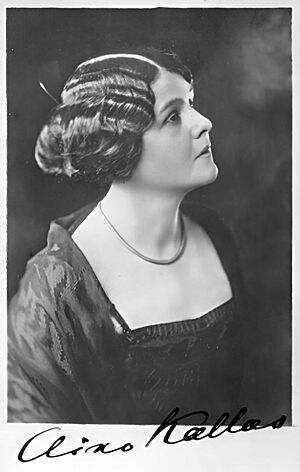Aino Kallas facts for kids
Quick facts for kids
Aino Kallas
|
|
|---|---|

Aino Kallas
|
|
| Born | 2 August 1878 Kiiskilä, Viipuri Province, Grand Duchy of Finland |
| Died | 9 November 1956 (aged 78) Helsinki, Finland |
| Pen name | Aino Krohn, Aino Suonio |
| Nationality | Finnish |
| Genre | Symbolism, Neo-romanticism |
| Spouse | Oskar Kallas |
| Children | 5 |
| Parents | Julius Krohn Maria "Minna" Wilhelmina Lindroos |
| Relatives | Aune Krohn (sister) Ilmari Krohn (half-brother) Kaarle Krohn (half-brother) Helmi Krohn (half-sister) Salme Setälä (niece) |
Aino Krohn Kallas (born August 2, 1878, died November 9, 1956) was an important writer from Finland and Estonia. She wrote many short novels, called novellas, which are famous in Finnish literature.
Contents
Aino Kallas's Life Story
Aino Kallas was born in Finland. Her father, Julius Krohn, was a well-known Finnish scientist. He was also one of the first people to publish poetry in the Finnish language. Aino's siblings, Kaarle Krohn and Helmi Krohn, also became writers.
In 1900, Aino married Oskar Kallas. He was an Estonian expert in languages and folklore. He later became a diplomat. Aino and Oskar lived in Saint Petersburg at first. They had five children together.
Moving to Estonia
In 1904, the family moved to Tartu, Estonia. Aino became very interested in Estonia's history and culture. She joined a group called Noor-Eesti. This group worked to help Estonia become an independent country.
Even though Aino wrote in Finnish, her stories often focused on Estonian topics. From 1922 to 1934, she lived in London. This was because her husband was Estonia's ambassador to the United Kingdom.
Her Writing Style

Aino Kallas often wrote about a strong kind of love. She called it "the slaying Eros." This means a love that sometimes leads to sad endings, even death. This theme is clear in her three famous novellas:
- Barbara von Tisenhusen (1923)
- Reigin Pappi (The Pastor of Reigi, 1926)
- Sudenmorsian (The Wolf's Bride, 1928)
The Pastor of Reigi and Barbara von Tisenhusen were translated into English in 1927. They were published together as Eros the Slayer.
The Wolf's Bride
Her most famous story is Sudenmorsian, or The Wolf's Bride. It is a werewolf story set in the 1600s on an island called Hiiumaa. The language in this story is very rich and old-fashioned. This style became a special part of Aino Kallas's writing.
Her short story Imant and His Mother was even turned into an opera. The Finnish composer Tauno Pylkkänen created the opera Mare and Her Son in 1935.
Awards and Recognition
Aino Kallas received several awards for her work:
- Order of Merit of the Estonian Red Cross, III class (1938)
- Aleksis Kivi Award (1942)
Her Legacy
Today, there is an award named after Aino Kallas. It is called the Aino Kallas Award. This award honors people or groups from Estonia who have greatly helped cultural connections between Estonia and Finland.


